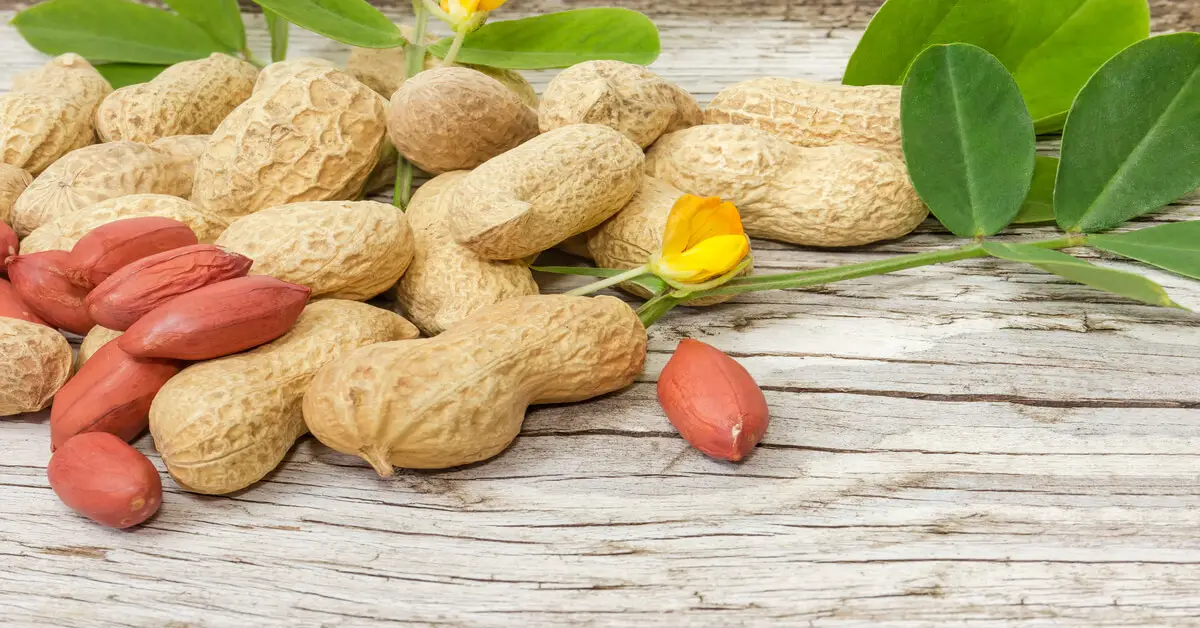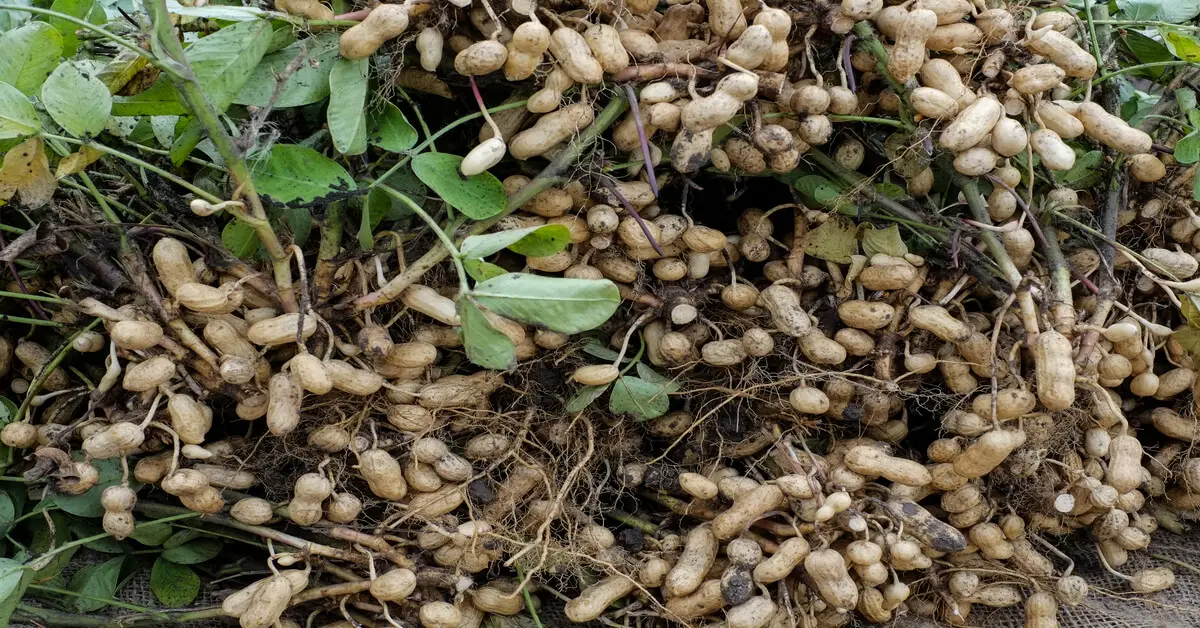The Peanut Plant is an annual herbaceous plant. Indigenous to Bolivia, Peru, and Paraguay. But is now widespread throughout the world.
The domesticated peanut (Arachis hypogaea) does not exist in the wild. And is possibly a hybrid of two wild species (Arachis ipaensis and Arachis duransis).
As members of the bean or legume (Fabaceae) family of plants, peanuts make great soil builders. Their roots contain many nitrogen-fixing bacteria which enrich the soil. This makes them great for planting as second crops. Especially after harvesting plants such as tomatoes, carrots, or beets.
Other common names include the groundnut, goober (US), pindar (US), and monkey nut (UK).
Peanut Plant Care
Peanut plants can grow up to 12-24 in. (30-60 cm) tall, and produce compound leaves with 2 pairs of opposite elliptical leaflets, each 0.8-3 in. (2-7.5 cm) long.
Like prayer plants, the peanut is nyctinastic. Meaning their leaves close up at night and open up during the day to catch sunlight.
Peanut plants also produce self-pollinating pea-like flowers with yellow petals. After a peanut flower is pollinated, the flower wilts and bends down. Burying the developing fruit (which later develops into the peanut pods we know) a few centimeters into the soil.
Peanuts are surprisingly easy plants to grow and care for. And their high source of protein, good fat and oil, vitamins (B, E), niacin, folate, and minerals (potassium, manganese, and phosphorus) make them a nutritious and delicious snack.
Soil
The best peanut growing soil is a deep, well-draining, loose (no crowding), light-colored, sandy loam soil. With slight acidity (pH 5.5-7.0) and moderate amounts of organic matter. [1]
Watering
Between 1-2 inches (2.54-5 cm) maximum of water per week is recommended year round. But this depends on the local conditions and the stage of the peanut life cycle.
Peanuts generally require lots of moisture during early germination (first 7-10 days) to properly take root. Followed by a drought-tolerant period requiring less water (days 10-50).
Water needs will then increase gradually from days 50-110 as the plant flowers and grows pegs. Water should be reduced within one month and stopped 2 weeks prior to harvesting (~120-150 days for roasting peanuts) or when leaves begin to wither. [2]
Lighting
Peanuts will flower and grow best when planted in full sun (~8 hours of sunlight). But it can also be planted in partial shade.
Humidity & temperature
Keep temperatures as close to 86°F (30°C) as possible for optimal growth. Temperatures above 95°F (35°C) will slow plant growth, and temperatures below 60°F (15°C) will result in little to no growth.
Peanuts are native to tropical and subtropical environments. So, they flower best in higher relative humidities (60-80% or higher).
Fertilizing
Peanuts indirectly obtain nitrogen from the air with the aid of nitrogen-fixing bacteria on their rhizomes. So, do not require much fertilizer.
For fields that have not seen peanuts, it is recommended that the seeds be inoculated. With the proper Rhizobium bacteria (usually sold as a powder legume inoculant).
Calcium and phosphorus may be deficient in non-acidic soil. So, consider adding a lime or other calcium fertilizer at planting.
Diseases & Pests
Fungal infections such as Botrytis blight (causing spots on leaflets and plants to wilt) may affect peanut plants. Along with other fungal infections such as leaf spots and leaf rusts. They can usually be treated with fungicides.
Peanuts are not particularly impacted by insects. Though they may encounter common pests such as wireworms, army worms, nematodes, cut worms, aphids, mites, thrips, and corn earworm. [3]
Hardiness Zones
Peanuts need hot summers and cannot tolerate frost. Commercial production is limited usually to the Southeastern and Southwestern United States (USDA hardiness zones 8a-8b, 9, and above).
Days to Maturity
Peanuts can reach maturity from 120-150 days after planting. But this largely depends on the varieties and growing season. 130-140 days after planting is typical for medium maturity varieties. With Virginia types running on the shorter end and runners on the longer end.
Types of Peanut Plants

There are many cultivars of peanut plants around the world. The Virginia, runner, Valencia, and Spanish peanuts are the most common commercial types in the United States. Runners are more than 80% of the peanuts grown in the United States. And are used mostly for peanut butter.
Virginias have larger kernels and are often used in ballpark stadiums. The Spanish variety is usually smaller when compared to the others and are known for their red skin and nutty flavor. Valencias have 3 or more kernels in their shells and have a sweet flavor that are excellent for boiled peanuts.
How to Grow Peanut Plants
To grow peanuts, use fresh and uncooked peanuts still in their shells. Place about four shelled peanuts inside a plastic bowl with about 4 inches of moist potting soil. Then cover with about an inch of soil. Sprouts will quickly emerge and they can be transplanted outdoors when they do.
When plants are about 6 inches high, make sure to weed and loosen the soil around them to help the pegs penetrate the ground easily.
Harvesting Peanuts

Peanut leaves will yellow and wilt when they are ready to be harvested. From around 130-140 days for medium varieties. Peanut pods will also darken and the peanuts themselves will darken. From white or pale (unripened) to pink or copper-red color (ripened).
References:
[1] Kumar, R. G., Panicker, G. K., & Chukwuma, F. O. (n.d.). Peanut: A Soil Conserving Leguminous Oil Crop. Cooperative Extension School of Agriculture, Research, Extension, and Applied Services, Alcorn State University. Retrieved October 12, 2022, from https://www.alcorn.edu/uploaded/Extension/Technical_Notes_Peanut.pdf.
[2] Paul L. Hollis Farm Press Editorial Staff, (2018). Timing critical in watering peanuts. Farm Progress. Retrieved October 12, 2022, from https://www.farmprogress.com/timing-critical-watering-peanuts
[3] Unknown Author, (n.d.). Peanut (groundnut) | Diseases and Pests, Description, Uses, Propagation. Plant Village, Penn State University. Retrieved October 12, 2022, from https://plantvillage.psu.edu/topics/peanut-groundnut/infos.

